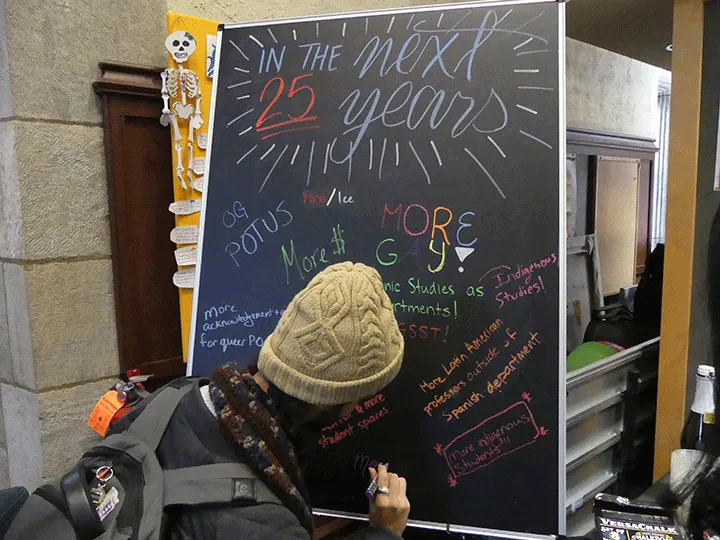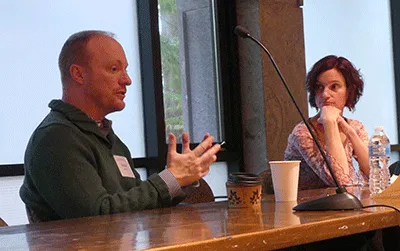Swarthmore Hosts All-Day Celebration, Exploration of Queer History and Activism

During an event to celebrate the Intercultural Center's 25th anniversary, a student writes hopes and goals for the IC's next 25 years.
As part of its ongoing celebration of the 25th anniversary of the Intercultural Center (IC), the College recently held an all-day celebration of queer history and activism entitled “Past to Present: Queer Identity at Swarthmore."
Sponsored by the IC, the Alumni & Parent Engagement Office, and the Sager Fund, the event opened with a recorded message from Richard Sager ’74, a leader in the gay community of San Diego, Calif., who established the Sager Fund in 1988. Sager reflected on his own time at Swarthmore when the IC did not yet exist.
"Today as we celebrate the silver anniversary of the Intercultural Center, we honor the intersections of activism and identity and the last 25 years of queer history," says Sager, who credits Swarthmore with developing in him "the empathy for different perspectives and the methodology for creative problem solving."
Four alumni followed Sager in considering queer identity on campus while they were students. Teacher and administrator Janet Chance ’87 was not out while she was a student at Swarthmore, she said. She comes from a Christian family and had been sent to a Christian Fundamentalist camp that imparted negative messages about queerness while she was growing up. For Chance, Swarthmore presented a “big time of grappling” but was also an intensely exciting time, as many of her friends were coming out to the community. Her experience talking with friends about identity and queerness while at Swarthmore played a large part in her decision to come out five years later, she said.

Patrick Egan ’92 and Jennifer Koosed ’93 at the second panel of the "Past to Present: Queer Identity at Swarthmore" event.
Senior medical writer Catherine Sears ’89 recalled that she was “always attracted to gay culture” while growing up. When she arrived at Swarthmore, she lived on a hall in Wharton with two upperclassmen who were two of the best-known queer activists on the campus at the time, and they adopted her when they saw the pride posters in her room. However, Sears admitted, “I wasn’t sure if that was what I identified with when I got there.” Like Chance, attorney Murray Scheel ’86 was not out at Swarthmore. He recalled that he “couldn’t figure out an intellectual framework in which to say ‘gay is good’” at that time in his life. However, he later noticed that by repressing his identity, he was not growing up and was not having many of the experiences that people need in order to grow up. He ultimately realized that coming out was “a moral imperative” for him. Considering the implications of not coming out until his mid-twenties, Scheel noted that he spent “a really formative part of [his] life keeping a huge secret” and that, consequently, he still tends not to divulge much personal information about himself. However, he recognized that coming out late might actually have saved his life: by the time he made his queer identity pubic, HIV was fairly well-understood, which was not the case when he was younger.
Sears also reflected on trans identity at Swarthmore. While there were no trans students or groups on campus at the time, William R. Kenan, Jr. Professor Emerita of Art History T. Kaori Kitao had recently come out as a woman. Kitao was the first trans person Sears had ever encountered and, she recalled that at the time, Swarthmore did not have any sort of vocabulary for trans identity.
Patrick Egan ’92, an associate professor of politics and public policy, spoke last. He reflected on how there was “no formal institutional support for queer kids” during his time at Swarthmore, and that he is glad to see the current administration, faculty, and staff so committed to “advancing and sustaining queer life at Swarthmore.” Egan recalled arriving at Swarthmore during the fall of 1988, the high point of gay men dying of AIDS and the middle of the Reagan-Bush era. “The association between queer and death was quite prominent in the way people thought about being gay,” he explained. He noted that Swarthmore’s size makes coming out a discrete event rather than a continuous one: coming out happens all at once because everyone knows everyone else. While Egan never experienced any homophobia while at Swarthmore, he remembered that the small queer population sometimes made it difficult to find one’s circle. However, he is grateful to the IC for bringing together many different groups and helping them understand their identities and commonalities.
A second panel in the afternoon focused on the creation of the IC. Egan and Jennifer Koosed ’93, a professor of religious studies, spoke about campus culture during the year the IC was created, before the event concluded with a reception in the IC.
Reflecting on the panelists’ perspectives, Associate Dean of Diversity, Inclusion, and Community Development T. Shá Duncan Smith notes the importance of their experiences of what it was like to be queer on this campus in comparison to the experiences for today’s Swarthmore students who identify as LGBTQ.
“The College has to continuously look at how much progress has been made,” says Smith. “I think assumptions are made about how progressive the world and our campus community is when it comes to creating a truly inclusive environment for campus community members who identify as LGBTQ. While we celebrate our progress, we continue to hold the mirror up as we demonstrate our strong commitment to do more.
“Together, we can do a better job at building an inclusive community,” she adds, “where all students, faculty, and staff can thrive, participate fully, and bring their entire selves to the Swarthmore community."
The IC has multiple events planned for the spring semester to continue the celebration of its 25th anniversary, including events highlighting women of the IC and former student leaders.



